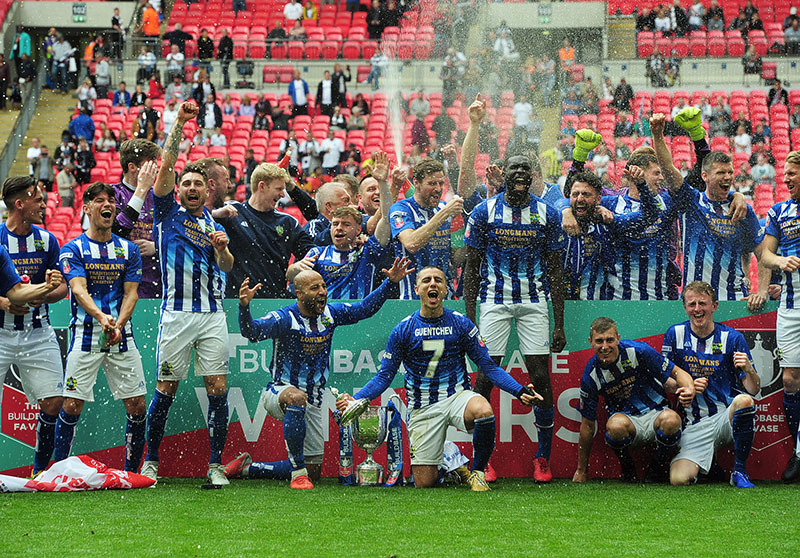
In recent years they’ve played with a single volunteer on the bench and had a game postponed through lack of socks – but it all went right on the non-League club’s big day out in May
8 July ~ It was mid-afternoon on a warm Sunday in May when I collapsed back into a Wembley Stadium seat and cried like a baby. The outpouring of unbridled emotion was triggered by a goal of beauty, scored by Chertsey Town’s Quincy Rowe. The strike sealed a 3-1 victory for my Surrey club and it was at that moment, deep into extra time, FA Vase victory was ensured. I celebrated without a scrap of dignity.
A few days later, still an emotional powder keg and prone to bursting into tears without warning, I watched a BBC Surrey interview with club stalwart Chris Gay who has been at Chertsey Town for well over 40 years. He talked of the hard times he’d experienced at the club, referring to them as “the fallow years”, and how important they had been in preparing the club for this moment. He’d hit the nail on the head.
I’d not been at the club anywhere near as long as Chris. I moved to Chertsey in 1997 and, before relocating to Sheffield halfway through last season, I’d spent the best part of 20 years as a fan and for the last 12 or so years written match reports for the club, a role that took me to nearly every game home and away. Over time I became good friends with committee members and, along with a small bunch of dedicated supporters and players’ relatives, I spent more time with these folk than with my own family. I experienced many of those fallow years first-hand and, with a dose of irony that football often prescribes, it was when I moved away that Chertsey Town started to do well.
The 2018-19 season was Chertsey’s most successful, surpassing anything that had gone before in their 129-year history. In the time I spent at the club, measures of success were relative. In 2011 they gained a promotion from the Combined Counties League (five levels below the Football League), but only on a technicality after champions Guildford City were denied promotion for failing ground grading. Chertsey were relegated three years later. In 2010 the club reached the fifth round of the FA Vase and, in front of a crowd the size of which I’d never seen before at Alwyns Lane, held eventual winners Whitley Bay to a draw before losing the replay.
The fallow years were hard for all involved, with some painfully low points. In November 2011 the owner and manager Spencer Day left to take over at Farnborough and the majority of his players went with him. The following Saturday we faced an away trip to St Neots Town without enough bodies to conjure up a starting XI, with youth-teamers and loanees corralled in a matter of days to ensure the fixture went ahead. A young helper at the club was contacted the night before and asked to bring his boots. He was the only person sitting in the Chertsey dugout to witness a 7-0 defeat. In my time there the club spent several seasons flirting with relegation in front of sparse crowds; poor performances and heavy defeats on cold winter nights with fewer than 50 people watching became the norm. Wembley was only 20 miles around the M25 but it might as well have been a million.
The reality of non-League life for many clubs is survival rather than success and sometimes dealing with the simple basics can be a struggle. I bore friends with the story of turning up for a midweek home fixture against Badshot Lea several seasons back and how, within minutes of walking through the turnstile, the game was called off because of a clash of socks. Chertsey had only one set of socks at the ground that evening and the opposition had turned up with socks the same colour. Despite offers to the referee that one of us rush over to Sports Direct in Staines to buy a new set, he was having none of it. Only in non-League.
The day before Chertsey’s win at Wembley Manchester City were setting records of their own, thrashing Watford in the FA Cup final. My father, a season ticket holder at City since the age of 17, was understandably pleased with the result but has seen it all as far as his club is concerned. By comparison, Chertsey fans have seen very little. Maybe for that reason alone it made the moment I stood with my son looking at the famous arch from the steps of Wembley Park station particularly special.
The Premier League champions played only five ties to reach their Wembley final; by the time they opened their FA Cup campaign against Rotherham United in January, over 600 clubs had already been knocked out of the competition. Chertsey started their FA Vase run at the very first qualifying round, one of 638 clubs harbouring a not unrealistic dream of reaching this year’s final, and it took the Curfews ten games to do so.
Wembley Way, a heaving mass of sky blue and yellow only a day earlier, was sparsely populated with a handful of Chertsey and Cray Valley fans, all looking bemused, shocked and overwhelmed in equal measure. As we pinched ourselves at the sight of Chertsey’s name emblazoned across the side of the stadium, a couple of City fans, totally unhindered by crowds, walked back towards the station, travel bags wheeled in tow. Their Nike shirts bore the name “Etihad Airways”. Across our Chertsey shirts were the words “Longmans Traditional Sweet Shop”.
Success in football is relative. Many of us who follow non-League and have close connections with clubs at that level will argue that Chertsey’s Wembley win on that warm May weekend was far more remarkable than Manchester City’s. The long-serving committee at Chertsey have never known anything like it, never thought they ever would, and most likely never will again. These are the people I cried for. Andy Ollerenshaw
Photo by Colorsport
This article first appeared in WSC 389, August 2019. Subscribers get free access to the complete WSC digital archive – you can find out more here
